What is the Google Search Console?
The Google Search Console was originally called Google Webmaster Tools, but its platform has changed a lot since those days. The idea that website owners themselves could control some of their success on Google was a revolutionary idea at the time. Google was putting a lot of faith in content creators and businesses here, trusting that by giving them the Google Search Console, they could more accurately create a search engine that reflects the active web.
Imagine a platform that lets you talk directly to Google and tell it about your website. It shows you how to index url in Google, submit url to Google, and even crawl fetch as Google. It’s a lot of power to put in a site owner’s hands, and of course, site owners instantly began trying to master this newest enigma from Google. Its interface was enhanced and updated in 2018 to reflect social media websites and mobile platforms as well.
If you don’t even know what Google’s Search Console is at all, then a simple definition is that it’s the section of Google where a website owner needs to live and breathe if they want to survive online. Given that the majority of all organic search traffic flows from Google, the Search Console is the holy grail of online traffic. To get traffic organically, you’ve got to master the Console. This is a brief guide that shows you how to do that.
Google Webmaster Tools
Google Webmaster Tools was the former name of the Search Console, but some of that platform has carried over into the new edition. The term “webmaster” might not be used today as much as it used to be, but anyone who has had a site online in the last 15 years knows the term and that it basically means you’re the commander of your own site. You’re the person responsible for making sure your site is visible to search engines and gets indexed the way it should be. Today’s “Google Webmasters” entry page is your introduction to the Search Console.
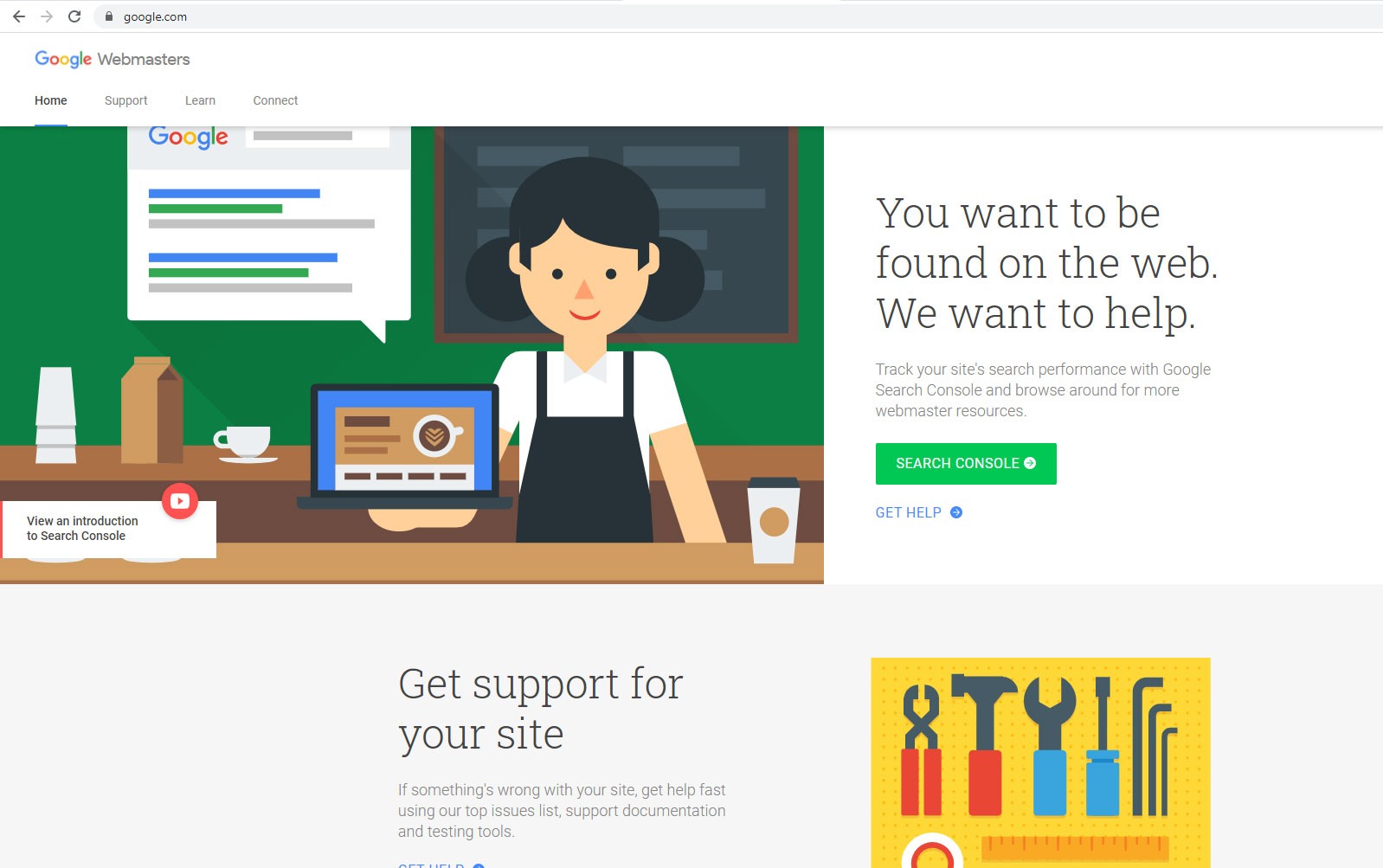
Once you’re on the Google Webmasters page, it will tell you the four primary things that you now have access to. The first of those things is the Search Console, a place where you can track your site’s performance, submit URLs to Google, and then use other webmaster tools. Three other services are also available that they lay out for you:
- Site support
- Site creation courses and resources
- Basics news for webmasters
The holy grail of how to index URLs in Google will be found within the Search Console only, but watching videos on how to create better websites – as outlined by Google itself – is always a good idea. Why? Well, according to search engine statistics, Google is so important to webmasters that it accounts for almost all online search traffic. The #1 position in Google, as outlined in the previous resource, nets you 33% of traffic from a certain keyword. So you can see why you’d want to nab that #1 spot or get as close to it as you can.
How to Use the Search Console
The Search Console is a robust tool with many functions that we’ll briefly cover here today, but we’re most concerned about how to simply get a new website’s pages indexed. If you’re looking for a quick primer on how to accomplish that very important feat, this is it.
Outline of the Console
Your Search Console is a simple dashboard set-up, a very old school design with minimal visuals and deep stats prioritized over fancy animations. It very closely mirrors Google’s own simple style that never seeks to fancy up information and instead lets its robust functionality speak for itself. When you log in, you’ll see a dashboard that has links to:
- Search appearance
- Search traffic
- Google index
- Crawl
- Security issues
- Other resources
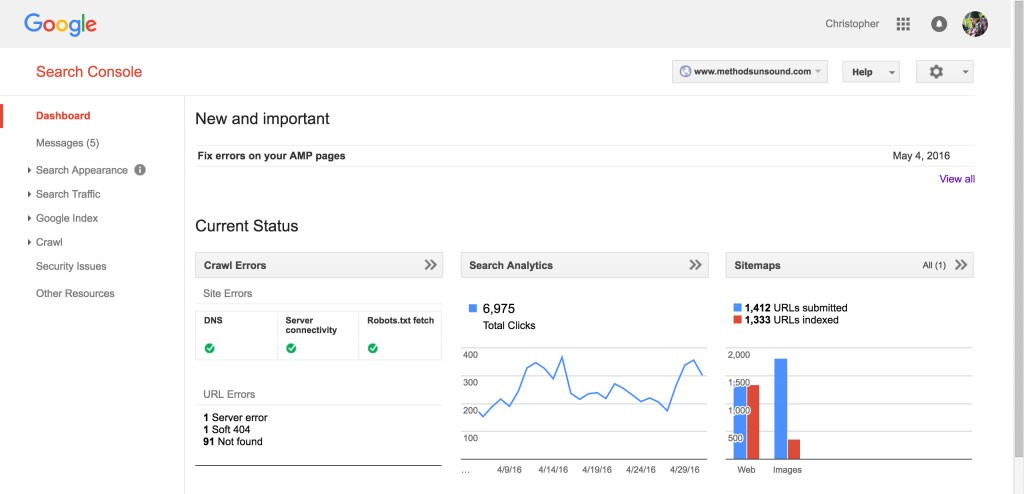
(Image Credit: Search Engine Watch)
Crawl
Before indexing, you’ll want to crawl your website and get a clear picture of where you’re at right now URL wise. The Crawl section of Search Console is one of its most useful features because it allows you to peer at your website through the eyes of the Google crawler (or spider as they called them in the old days). The crawl fetch as Google is different from the Google URL inspection tool (covered later in this guide).
Under crawl, you’ll be able to fetch as Google, meaning that you take the form of Google and have access to all the data they have learned during their crawl of your website. It’s a genius sneak peek at how Google sees your site and what kind of errors you might have going on with your code or content. You’ll be able to see any crawl errors, if the spider can crawl your site successfully, confirm you have a live sitemap, and even look at stats Google has after crawling your site. Take a look at this image showing crawl errors:
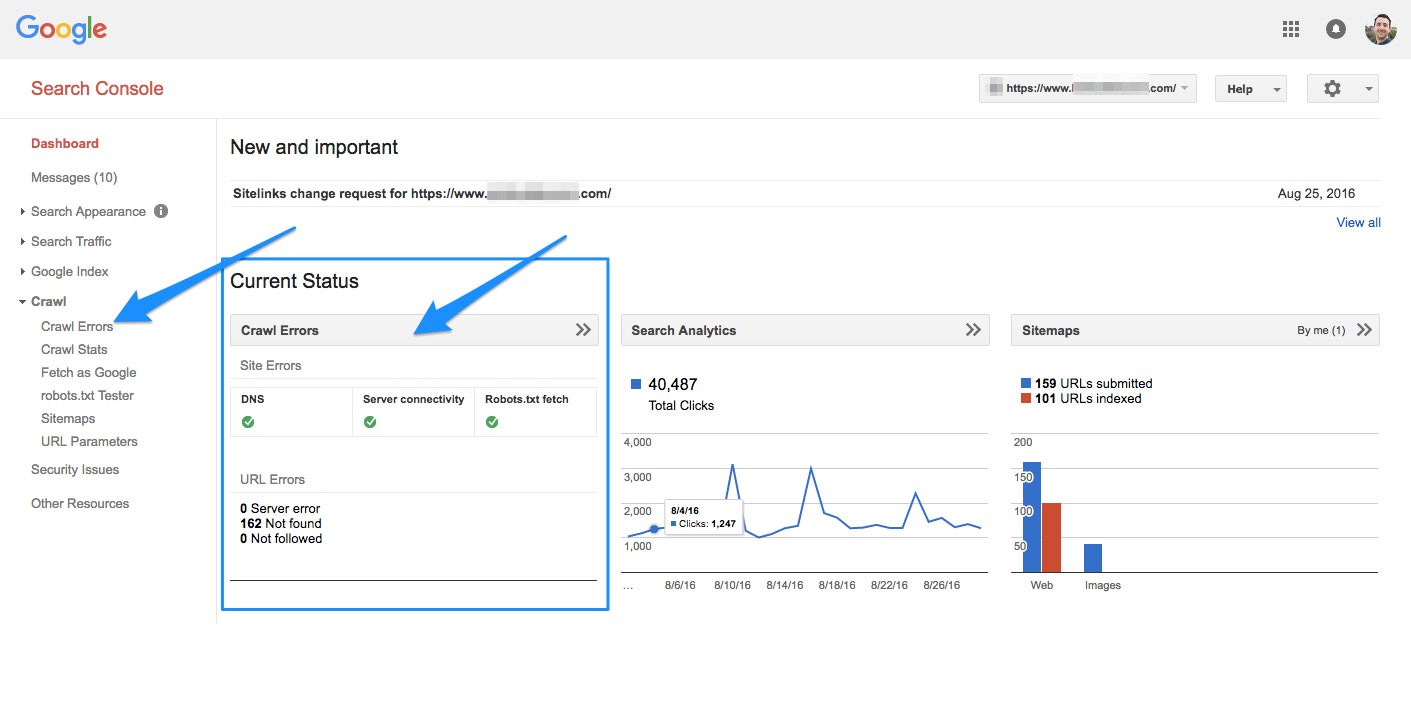
You Might Also Like
(Image Credit: Moz)
The usefulness of this tool can’t be overestimated, and it’s something that many webmasters use on a regular basis to ensure that Google is able to crawl their site and index. If there’s a crawling problem, there will be an indexing problem. Millions of site owners are able to utilize this tool and tweak their sites/codes as needed to make sure that the Google crawler has a clear path to all of your important pages.
Stats
Your crawl stats have a lot of valuable information as well. They’ll tell you if you have any pages that have gone missing in action (404), let you know if these pages haven’t been indexed at all by Google, and even tell you if your submitted URL is not selected as canonical. It can also let you know if there are any unwanted redirects on a page so that you can correct. Stats are only there to identify errors and issues. They won’t fix things by themselves. To get things fixed, you’ve got to take notes and really adjust based on your stats.
Test your SEO in 60 seconds!
Diib is one of the best SEO tools in the world. Diib uses the power of big data to help you quickly and easily increase your traffic and rankings. We’ll even let you know if you already deserve to rank higher for certain keywords.
- Easy-to-use automated SEO tool
- Keyword and backlink monitoring + ideas
- Speed, security, + Core Vitals tracking
- Intelligently suggests ideas to improve SEO
- Over 500,000k global members
- Built-in benchmarking and competitor analysis
Used by over 500k companies and organizations:
Syncs with 
Time to Index
Your whole goal when you create content online is to make sure that Google can see that content. You don’t just want it to be indexed, though. You want it to be indexed and, ultimately, ranked high in search engine results and at the #1 position. To get there, you have to first have your site indexed, and this is a guide to making sure that all of your site’s pages are indexed by Google. The Search Console is your #1 way to make sure that all of your pages are indexed properly.
There are two ways to request Google crawl your site. One is called the Google URL inspection tool and the other is by submitting a current Sitemap from your website. Here is what a sitemap might look like:
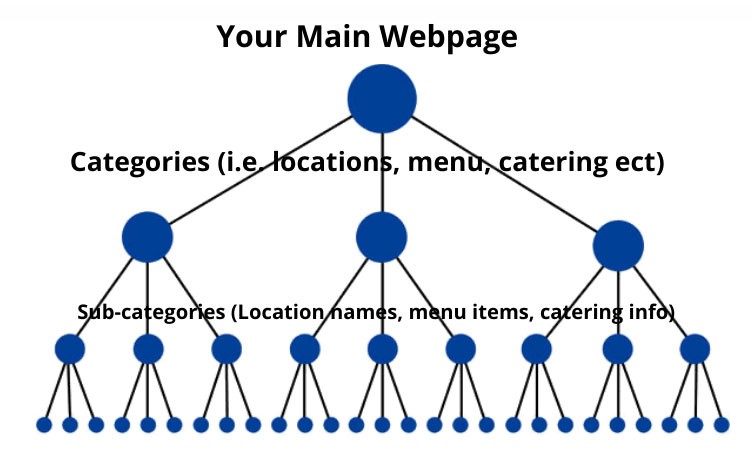
Both of these tools will be effective in getting your site indexed, but you can also double up and use both methods. You can update a Sitemap in real time as your pages are added, so keeping the Sitemap current on Search Console is a good way to stay indexed.
Google URL Inspection Tool
The Inspection Tool is generally used to submit individual URLs from a site. If you have a website that’s constantly changing and being updated with thousands of pages over the years, you’ll quickly see why this method would take forever and should probably be used mostly by smaller sites with highly targeted content and just a few pages. How do you get indexed this way?
- Inspect the URL using this tool.
- Choose Request Indexing.
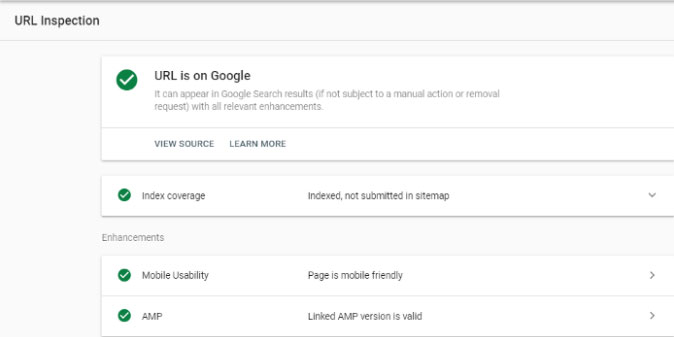
As Google reminds users, there’s no instant way to be indexed. You won’t request indexing today and then suddenly find all of your pages are indexed tomorrow. It can happen today, tomorrow, a month from now, a year from now, or never at all. Google gets a lot of requests from millions of sources. They must put you in a queue, and we all know a queue isn’t the same thing as real-time. Be patient. If your content is legitimate and useful, Google will get around to it.
Sitemap
Large sites with constantly updating content should use Sitemap without fail. A Sitemap is basically a list of every URL on your website and a timestamp of when it was last updated. It’s a near real-time way to let Google know that you’ve got new content and this is when it was added. It also keeps track of all your old URLs and is a short and sweet version of your content’s addresses. You can submit a sitemap in 4 different ways.
- Use the ping tool
- Insert Sitemap: http://example.com/my_sitemap.xml in your robots.txt file
- Use the Search Console’s Sitemaps report (Look below for an example)
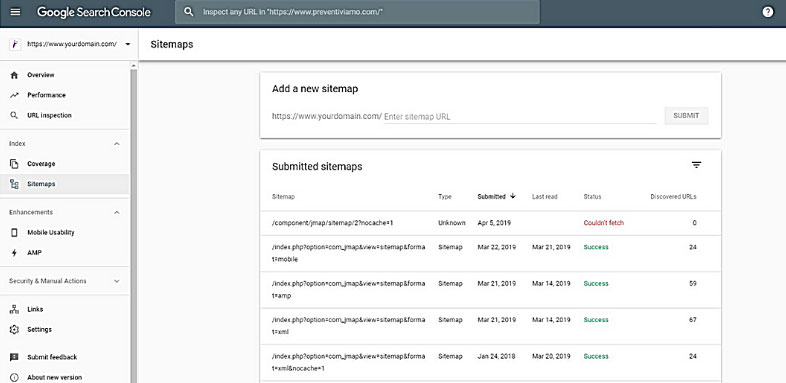
(Image Credit: Search Engine Land)
Keeping Up with the Index
Once you’ve submitted your pages for indexes, it’s natural that you’d want to monitor their progress. Google doesn’t often index everything all at once into a neat, nice little straight line. They might prioritize some pages and view them as more worthy of indexing first. Other pages might be left off for a month. In order to help you keep up with index status of your pages, the Google Index Checker was created. Here is an example of the results:

(Image Credit: Linkody)
This simple tool allows you to see the status of your submitted pages. Have they been crawled? Indexed? You’ll get an overall total for all pages on your site and then a few more helpful tidbits of information that give you a real picture of how your indexing adventure has gone. When you use this tool in conjunction with Google’s Search Console, you drastically increase your chances of being indexed higher in search results on keywords that are accurate and profitable for your website.
Aim High, Rank High
Google’s Search Console and Google index checker are just two tools that are designed to help people like you be ranked higher on keywords that will bring in targeted traffic to your website. Targeted traffic means that you’re not just pulling in any old visitor to your site. It means you’re attracting clicks from people who are actually interested in what your site has to offer. For a site that sells shoes, success would mean being indexed high for searches like “where do I buy a new pair of shoes?” Specific, shorter strings like “new shoes” would obviously be a phrase you’d want to rank for as well.
There’s always a path to get more traffic, but getting quality traffic is what most site owners want. If you bring in people who are there by accident and didn’t actually have an interest in your content and/or product, then you’re wasting SEO resources by ranking for some keywords and perhaps ignoring others that would be more successful for you.
Visibility is always the starting point, though, and simply being indexed by Google is going to be a winning first step for your venture. If you’ve got brand new content on a brand new site that’s as yet unknown to the world, Search Console is your main transportation to greater things. It will bring in new readers and customers if you use it correctly.
The initial goal of a website might be to just be indexed at all. Just seeing URLs go live and rank even in the top 100 pages might be comforting. Seeing your own main URL as searchable and visible in any result is a nice feeling for any new website. Ultimately, though, the goal of Search Console is to use its tools to rank higher and higher as you continue building your online presence.
We hope that you found this article useful.
If you want to know more interesting about your site health, get personal recommendations and alerts, scan your website by Diib. It only takes 60 seconds.
Get Started and Rank Higher
If your website isn’t indexed yet, the best time to start that project is today. Even if you have a high quality, useful service or product to offer up, there isn’t a road map to your site that you can hand out to billions of people. You have to become visible to them so that they find you, not the other way around.
This has always been the intriguing part of building an online business. In a real world setting, customers simply live in the community where your business exists. They see it, walk inside, and interact. There may only be a few other businesses of your kind in the area where a physical local business is. Online content changed things entirely.
You’re competing with billions of other online records and addresses that show up in search engine results; you’re also competing with endless streams of free content and samples and information. It can be hard to become visible in this kind of environment, but if there’s one way to create a strong and positive online presence, it’s through organic search results. A total of 53% of website traffic comes from organic search results.
You can buy ads down the road. You can market on social media. You can work to attract mobile audiences and expand your content. However, the bulk of all your traffic that’s quality, targeted, and profitable is still going to come from just being ranked high in Google search results through natural indexing.
Indexing still matters. Mobile apps and social media definitely play a supplementary and important role today in growing an online audience, but nothing will ever be as cheap and natural and profitable as good old simple search. And all of the success you’ll ever have begins with Google’s Search Console.
When you first sign up for Search Console, you’ll be asked to submit your domain or URL Prefix (a new feature this year). In order to get started, you’ll need to verify your website. Once you’ve verified by DNS record or meta record (or multiple other ways Google has set up to help you verify that your site is really your site), then you unlock all the good stuff that comes with Google’s simple indexing tool.

(Image Credit: ahrefs)
Getting indexed online isn’t hard, but indexing high in search results is going to be a full-time task for someone who doesn’t know a lot about search engine optimization. That’s one reason why free tools like Search Console are so invaluable. You get almost instant access to Google’s methods and tools, all without having to pay a dime for the service. You can use the money you save by getting indexed here and using this tool to go to other things down the road, like paid SEO services that help you automate SEO of your content and business products or services.
Diib®: Your Indexing Experts!
Like all good tools, the Search Console is simple to use on the surface and powerfully complex and productive underneath that simple exterior. Any website owner who wants to succeed is going to profit from a long “getting to know Search Console” session today. Diib integrates with Google’s Search Console to bring you the most up-to-date and in-depth analytics available. Here are some of the features that compliment your Google Search Console profile:
- Google Core Algorithm monitoring
- Link auditing
- Alerts to broken pages where you have backlinks (404 checker)
- Keyword, backlink, and indexing monitoring and tracking tools
- Alerts and Objective that guide you to strengthen your website
Click here for your free 60 second site analysis and industry ranking or call 800-303-3510 to speak with one of our Growth Experts.
FAQ’s
This is the URL removal process for Google Search Console: Go to this site: https://www.google.com/webmasters/tools/url-removal. Select your website under “Please select a property” Click the grey button, enter your URL and click “Continue”.
First, perform a Google search for the page you are looking for. Click the result with the URL you need. This will take you to that site. In the browser address bar (at the top of the page), select and highlight the entire URL. Copy by right-clicking the URL and selecting Copy. Then paste the URL by also right-clicking it.
First, you’ll need to perform a fetch or fetch and render request using Fetch as Google. Next, click “Request indexing” which is next to the fetch in the fetch history table. Select whether you want to crawl that URL only or that URL plus any direct links.
Go to the Google URL shortener site located at goo.gl. Sign in (unless you’re already signed in). Write or paste your long URL in the box. Click “Shorten URL”.
This means manually submitting your URL to search engines for faster indexing. This process can take anywhere from two to four weeks to complete. This helps SEO efforts immensely.



